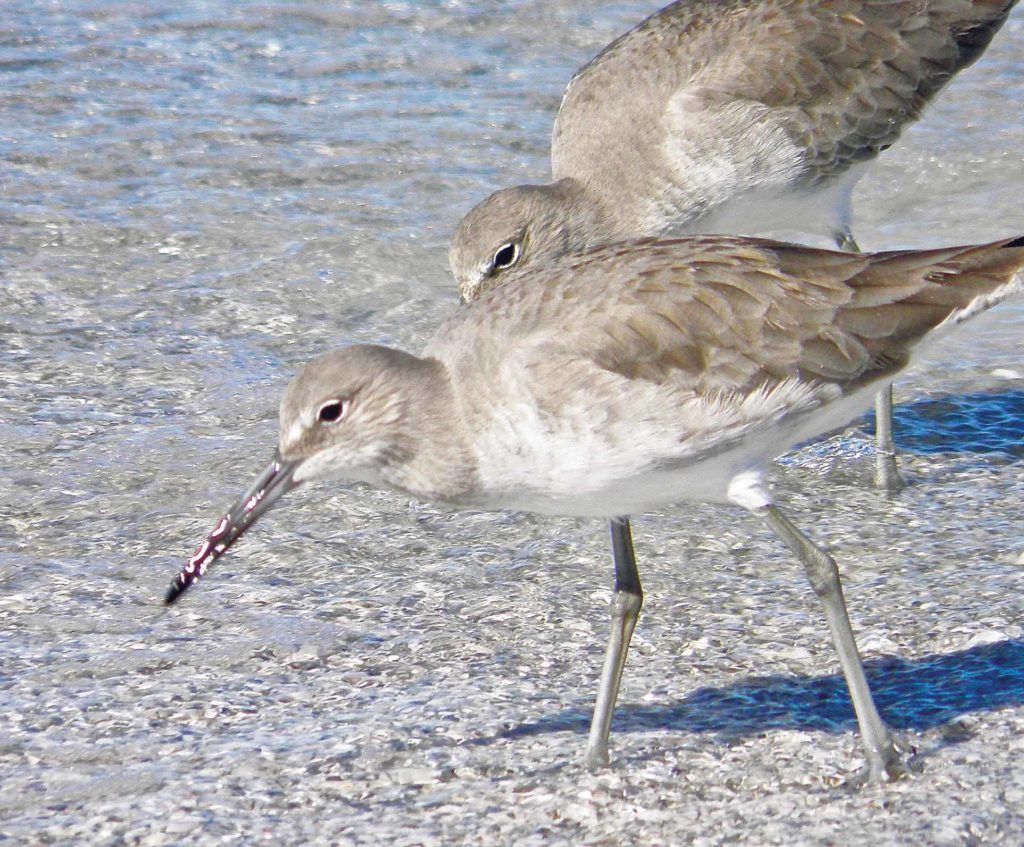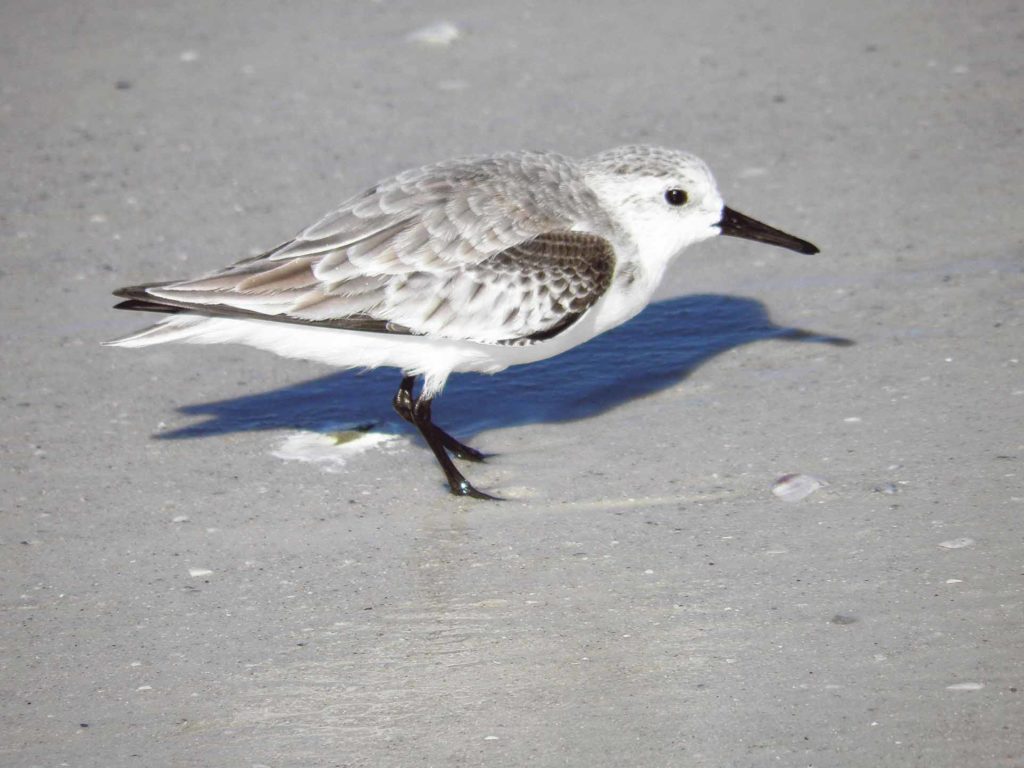
Sitting on a chair at the rear of the beach, I’m focused on a ridge of sand backed by blue sea. I’m carefully looking for any movement, no matter how slow, along that ridge which would indicate small shorebirds. After a minute I’ve picked up significant motion and I’m sure that there are a few black-bellied plovers, sanderlings and some semipalmated sandpipers over there.
Scared Stiff
There are clumps of seaweed along the tidal line. Appearing from the light-colored sand and seaweed are “peeps,” a collective term referring to small brown shorebirds. The two here are black-bellied plovers and sanderlings. Sanderlings, a mid-sized sandpiper, usually chase after retreating waves to peck morsels out of the soaked sand and scurry onto the next. They do this in pairs or in small groups of five. This morning the tide is high and waves aren’t incoming so the sanderlings have to get morsels from elsewhere. Two sanderlings retrieve small bits of shell from the sand and seaweed and run with them to other spots to swallow their meager finds.
Territoriality is a basic fact of bird life even on a seemingly empty beach. For one bird to chase another when there’s plenty of unoccupied territory is normative. Most of these skirmishes mean “I’m the boss, don’t forget that.” One of the sanderlings is in front of me and the other mere feet from it. The one furthest flies directly to confront the one near me. Instantaneously, they are both going at it, a gaggle of furiously blurred wings rising into the air. Then, just like that, it’s over. They are now a yard apart on the sand, each having stretched out their bodies straight from head to tail.
The attacked bird remains that way a long time, not unfurling an inch. It seems scared stiff and is oddly strikingly beautiful. Normally, a dark brown area at the bird’s shoulder joint is a tell tale ID characteristic. Now, instead of being a large spot, it’s a long curved line. The bird’s design has gone from a simple, rich brown-over-white to one of bright white and dark-chocolate lines.
The attacked bird, still stretched out, moves awkwardly sidewards. The attacker may have encountered unexpectedly stiff resistance and isn’t relishing another encounter. The scared stiff bird stays in that position, but gradually returns to near normal posture and flies. I’ve seen many skirmishes, but never one with this result.

A Find
Some beach goers create art in the sand. On a sloping sand ridge written with gray shells is a message, “Life’s A Beach.” At another spot there is a large wheel made of seaweed with spokes made of shells. Looking at those shells I see an approximately 9-inch long, wide-ribbed Florida Horse Conch. Although native to Florida waters and is the state shell, it’s very rare on this beach. The Mayans used them as paint as ink holders, a bugle. Native Americans in southern Florida have attached them a wooden handle to use as a hammer handle and the body used as a drinking cup. They can grow to two-feet, but are rarely found in that size due to over collecting. The one that I’ve found is somewhat banged up but basically in decent shape. I hesitate about taking it because I haven’t really “found” it. Someone else did. I prefer to dig up shells or simply come across them on lightly traveled stretches of beach. However, the next high tide will probably return the shell to the sea. This is a find and too good to leave.
Welcome Back
Willets are the largest of our sandpipers at 14-inches. They are also a uniformly drab brown gray color. You can easily miss or ignore them because of their plainness. However, when they fly their white underwing pattern conspicuously flashes. Add their high piercing Duracell battery-like call and this is a bird I love. One flies onto shore from over the water, flashing its white underwing signaling it’s approach. Another flies in near the earlier arrival and they hunt for coquina shells together. Another takes off, its wings beating so fast they seem like twin engine propellers. There are five more that are slowly walking and casually hunting in a group. After a while I’ve counted 17 willets. Yesterday, there were a dozen. Last winter there were a total of 11 that I saw almost all winter and another 11 that I saw during our last week here. In two consecutive days I’ve seen more than I had all of last winter. In previous years this beach was rife with these birds. Last winter, I was afraid that they might be permanently gone. This gives me a high.
Walking back, I photograph a few of the semipalmated plovers on shell packed sand. These little birds have a sharp body design which include dark neck rings and small orange areas at the base of their bill and the same color legs. They are hard to photograph as they will walk out of good range when I approach. But today they aren’t going anywhere. As I move to get a good angle in front of one plover, two snowy plovers stand up in front of them. At 6.5-inches these birds look even smaller than they are. They are pale as the sand making them the hardest birds to see on the beach. With these birds one can look forever and still not see them when they are still because of their camouflage colors. The best way to see them is to simply stumble over one. Interestingly they don’t scurry off now as they often do but sit in the sand and pose. All morning I’ve made it a point to look closely but in this case being lucky is better.













